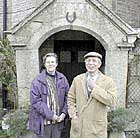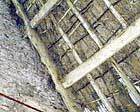

[the Knight team]
![]()
the Knight team
 |
Mary and Dick Knight |
The Knight family has lived and worked the land at Castle Farm -- about a mile from the centre of Marshfield -- for centuries. The task of the present-day Knights -- Dick, Mary and grandchildren Jacob and Miriam -- is to work out how much barley was being grown here in the heyday of the malting industry and to find out when that heyday was.
how they got on...
 |
Castle Farm |
CASTLE FARM
The Knights took part in the field walk with North Somerset county archaeologist Vince Russett and ten
schoolchildren. Vince told them to keep a special eye out for
fragments of malt tile and showed them an example of one.
Dick and Mary chatted with Tony Robinson about the history of Castle Farm, the chronology of the farm buildings and the land use. Dick told Tony that his grandfather was the last maltster in Marshfield, and once worked at No. 78 in the High Street.
HISTORY ROOM
No malting tile was found, but the following were:
late Neolithic arrowhead and scraping tool (c. 2000 BC)
Roman roof tile and piece of pottery
very early clay pipe (1620-40)
neck of a glass beer bottle (c. 1700)
pieces of ox shoes (18th century)
bits of jugs and tankards made of imported German pottery (18th century)
pieces of pre-industrial glass (pre-1850)
iron tenterhook (impossible to date)
History artist David Fisher made a drawing of the complete bottle.
CASTLE FARM
Dick, Mary and Vince returned to the farm to the longhouse where
dendrochronologist Bob Howard was taking cores from the timbers in order to date
the building. So far, this has stumped the experts -- archaeological,
architectural and historical -- with dates for its erection ranging
from 1300 to 1700. The Knights and Vince discussed the phasing
of the building, the thatched roof and other aspects of the interior.
 |
longhouse roof |
Some parts of the longhouse are obviously from other structures; the most significant bits of the original building were the purlins -- small, horizontal pieces in the roof. The early thatch nearest the eaves could be contemporary with the building -- some is attached to the purlins and tied with old man's beard (also known as wiswine) -- but it was impossible to find out. The longhouse was once part-residential but it also housed oxen, which would have tilled the land for barley. But was it a house that was turned into a barn or vice versa?
HISTORY ROOM
The Knights looked at the tithe map and award of 1841 with Vince and discussed field names and shapes.
Mary asked for an earlier map, and David Smith, county and diocesan
archivist at the Gloucestershire Record Office, brought over the
Maule Survey of 1768. Vince and the Knights talked about the Enclosures and their
effect on the landscape.
The Knights and History Hunters expert Mick Aston then looked at probate inventories of a Joseph England dating from 1707 and 1711, which contained descriptions of old farming and malting tools.
BATH
Dick and Danny White went to Bath to speak to Bob Howard via a
videophone to find out the dendrochronological results from the
core taken from the longhouse. The date was 1540, much older than
most people thought it was.
HISTORY ROOM
Mary took part in Vince's 'Antiques Roadshow', bringing along
several old barley-farming implements, which Dick had inherited
from his maltster ancestor, for him to examine.
THE CROWN
Mary went to this pub on the High Street to watch Dick performing
as Beelzebub in the mummers' play.